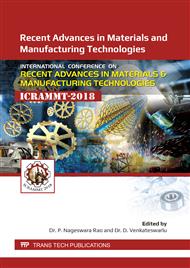[1]
M M Al-Tayeb, B A Bakar, H Ismail, H M Akil, Effect of partial replacement of sand by recycled fine crumb rubber on the performance of hybrid rubberized-normal concrete under impact load: experiment and simulation, Journal of cleaner production, 59 (2013) 284-289.
DOI: 10.1016/j.jclepro.2013.04.026
Google Scholar
[2]
N Holmes, K Dunne, J O'Donnell, Longitudinal shear resistance of composite slabs containing crumb rubber in concrete toppings, Construction and Building Materials, 55 (2014) 365-78.
DOI: 10.1016/j.conbuildmat.2014.01.046
Google Scholar
[3]
I Mohammadi, H Khabbaz, K Vessalas, In-depth assessment of Crumb Rubber Concrete (CRC) prepared by water-soaking treatment method for rigid pavements, Construction and Building Materials, 71 (2014) 456-71.
DOI: 10.1016/j.conbuildmat.2014.08.085
Google Scholar
[4]
Moustafa, Ayman, and Mohamed A. ElGawady, Mechanical properties of high strength concrete with scrap tire rubber, Construction and Building Materials, 93 (2015) 249-256.
DOI: 10.1016/j.conbuildmat.2015.05.115
Google Scholar
[5]
A S Hameed and A. P. Shashikala, Suitability of rubber concrete for railway sleepers, Perspectives in Science 8 (2016) 32-35.
DOI: 10.1016/j.pisc.2016.01.011
Google Scholar
[6]
N Banthia and R Gupta, Influence of polypropylene fiber geometry on plastic shrinkage cracking in concrete, Cement and Concrete Research, 7 (2006) 1263-1267.
DOI: 10.1016/j.cemconres.2006.01.010
Google Scholar
[7]
P Rossi, P Acker, and Y Malier, Effect of steel fibres at two different stages: the material and the structure, Materials and Structures, 6 (1987) 436-439.
DOI: 10.1007/bf02472494
Google Scholar
[8]
P E Peterson, Fracture energy of concrete: Method of determination, Cement and Concrete research, 1 (1980) 79-89.
DOI: 10.1016/0008-8846(80)90054-x
Google Scholar
[9]
H Šimonová, J Zahálková, P Rovnaníková, P Bayer, Z Keršner, P Schmid, Mechanical Fracture Parameters of Cement Based Mortars with Waste Glass Powder, Procedia engineering, 190 (2017) 86-91.
DOI: 10.1016/j.proeng.2017.05.311
Google Scholar
[10]
B L Karihaloo, Fracture Mechanics and Structural Concrete, Longman Scientific and Technical, New York, (1995).
Google Scholar
[11]
A Hillerbrog, Results of three comparative test series for determining the fracture energy G F of concrete, Materials and Structures, 18 (1985) 407-413.
DOI: 10.1007/bf02472416
Google Scholar
[12]
RILEM-Draft Recommendation, 50-FMC Committee Fracture Mechanics of Concrete, Determination of the fracture energy of mortar and concrete by means of three-point bending tests on notched beams, Materials and Structures. 85 (1985) 285-290.
DOI: 10.1007/bf02498757
Google Scholar


